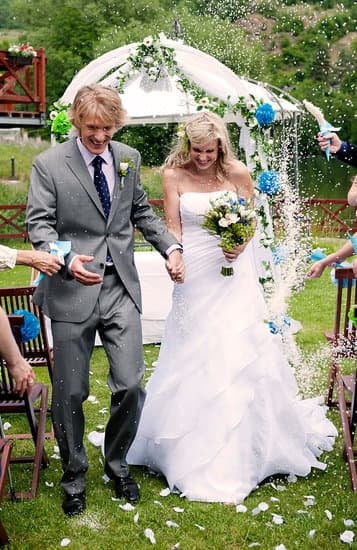Planning a wedding is an exciting time for many couples, but it often comes with the stress of managing a budget. The question of how much is too much for a wedding is one that plagues many soon-to-be-wedded pairs. In this article, we will explore the average wedding budget and provide insights into setting a realistic spending limit.
When it comes to weddings, costs can quickly add up. From the venue to catering to attire and grooming services, there are numerous expenses to consider. Understanding the average wedding budget and determining a personalized spending limit can help couples alleviate financial strain and ensure that they start their marriage on solid financial footing.
We will delve into various aspects of wedding planning, including how to find the perfect balance between cost and ambiance when choosing a venue, navigating the pricing of catering, and managing the guest list conundrum. Along the way, we will also provide tips on finding affordable attire without sacrificing style and budgeting for essential beauty services.
Wedding planning should be an enjoyable experience for couples as they prepare for their big day. However, it’s essential to approach it with a practical mindset to avoid overspending. By exploring typical wedding budgets and discussing when spending crosses the line from practical to extravagant, this article aims to guide couples in making informed decisions about their wedding finances.
Setting the Budget
Assessing Your Finances
Before diving into wedding planning, it’s crucial to assess your financial situation and set a realistic budget. Take a look at your combined income, savings, and any assistance from family members. Consider how much you are willing to spend on the wedding without going into debt or sacrificing other financial goals. It’s important to have an open and honest conversation with your partner about your financial resources and limitations.
Researching Average Costs
Educate yourself about the average costs of weddings in your area. Look into the typical expenses for venues, catering, attire, and other services. This research will give you an idea of what to expect and help you set a preliminary budget. Keep in mind that costs can vary widely depending on location, so be sure to factor in regional differences when determining your spending limit.
Prioritizing Must-Haves
Once you have a better understanding of your finances and average wedding costs, it’s time to prioritize the elements that matter most to you. Discuss with your partner which aspects of the wedding are non-negotiable and where you’re willing to compromise. By identifying must-haves early on, you can allocate more of your budget towards these priorities while being more conservative with less essential items.
When it comes to setting a wedding budget, it ultimately depends on personal circumstances and preferences. However, by carefully assessing finances, researching average costs, and prioritizing must-haves, couples can determine a spending limit that is reasonable for them without going overboard in their wedding expenses.
The Venue Dilemma
Planning a wedding involves many important decisions, one of the most crucial being the choice of venue. The venue sets the tone for the entire event and can significantly impact the overall budget. Here are some factors to consider when balancing cost and ambiance for your wedding venue:
- Location: Consider whether you want a local venue or if you’re willing to travel for a destination wedding
- Size: Determine how many guests you plan to invite in order to select a venue that comfortably accommodates everyone
- Amenities: Decide what amenities are essential for your wedding, such as a dance floor, bridal suite, catering services, etc.
- Time of year: Be mindful of peak wedding season and consider getting married during off-peak times for potential cost savings
When it comes to finding the perfect balance between cost and ambiance for your venue, remember that prioritizing what is most important to you and your partner will help guide your decision-making process. However, it’s important to keep in mind how much is too much for a wedding. It’s vital to set a realistic budget and stick to it in order to avoid overspending on unnecessary expenses.
Ultimately, the goal is to create a beautiful and memorable experience without going overboard financially. With careful planning and thoughtful consideration, it is possible to find a stunning venue that meets your expectations while staying within your budget constraints.
Dressing to Impress
When it comes to planning a wedding, finding the perfect wedding attire can be a top priority for many couples. However, the cost of wedding attire can quickly add up, leaving couples wondering how much is too much for a wedding outfit. Fortunately, there are several ways to find the perfect wedding attire without breaking the bank.
Setting a Realistic Budget
Before you start shopping for wedding attire, it’s important to set a realistic budget. Consider how much you are willing to spend on your wedding dress, groom’s suit, bridesmaid dresses, and groomsmen attire. Take into account any additional costs such as alterations, accessories, and shoes. By establishing a clear budget from the beginning, you can avoid overspending and financial stress down the line.
Exploring Affordable Options
There are plenty of affordable options when it comes to finding the perfect wedding attire. Consider shopping during sample sales at bridal boutiques or looking for gently used dresses at consignment shops. For groomsmen and bridesmaids, explore rental options or consider purchasing suits and dresses that can be worn again for other events. Additionally, keep an eye out for sales at department stores or online retailers for budget-friendly wedding attire options.
DIY and Personalization
Another way to save money on wedding attire is by getting creative with do-it-yourself projects or personalization. Brides can consider purchasing a simple dress and adding their own embellishments or alterations to create a unique look. Grooms may opt for personalized accessories or custom tailoring instead of pricey designer suits.
By incorporating personal touches and DIY elements into your wedding attire, you can achieve a stylish look without overspending. Ultimately, finding the perfect wedding attire without breaking the bank is possible with careful planning, exploring affordable options, and getting creative with DIY and personalization.
Feeding the Masses
When it comes to wedding planning, one of the biggest expenses couples face is catering. The cost of feeding all the guests at a wedding can add up quickly, so it’s important to set a budget and carefully consider your options. Here are some tips for navigating the pricing of wedding catering:
1. Determine your budget: Before you start looking at catering options, sit down with your partner and decide how much you’re willing to spend on food and drinks for your wedding. Consider how many guests you’ll have and what type of meal or service you want to provide. From there, you can start researching caterers that fit within your budget.
2. Explore different catering styles: There are many different catering styles to choose from, each with its own price point. Buffet-style meals are often more affordable than plated dinners, while food trucks or family-style service can also be cost-effective options. Consider what type of dining experience you want to provide for your guests and compare prices accordingly.
3. Get multiple quotes: Don’t just settle on the first caterer you find – shop around and get quotes from several different companies. This will give you a better idea of the average cost in your area and help you determine who offers the best value for your money.
Ultimately, navigating the pricing of wedding catering comes down to setting a reasonable budget, exploring different options, and doing thorough research before making any decisions. By taking these steps, you can ensure that you’re getting the best possible value for your money without overspending on feeding your wedding guests.
The Price of Beauty
When it comes to budgeting for makeup, hair, and grooming services for your wedding day, there are a variety of factors to consider. It is important to prioritize what aspects of beauty and grooming are most crucial to you on your special day.
This could include choosing between a professional makeup artist or doing your own makeup, hiring a hairstylist or opting for a DIY hairstyle, as well as factoring in the cost of grooming services for the groom. Additionally, you’ll want to consider whether any beauty treatments such as facials, manicures, or massages are included in your overall beauty budget.
The average cost of makeup and hair services can vary widely based on location and level of expertise. On average couples spend around $300-$600 on bridal hair and makeup combined.
It’s important to research local beauty professionals that fit within your budget range and schedule trials in advance to ensure the results meet your expectations. When setting aside money for grooming services, consider expenses such as haircut & style costs ($40-$100), beard trims ($20-$40) or other treatments like manicures or pedicures ($20-$50).
Setting a realistic budget for these services is essential when planning a wedding. Overspending on beauty services can quickly put a strain on your overall budget if not carefully managed. Finding ways to cut costs without sacrificing quality is key in order to avoid spending too much on these details – striking a balance that ensures you look radiant while not breaking the bank can be achieved with careful planning and consideration.
| Beauty Service | Average Cost |
|---|---|
| Bridal Hair & Makeup | $300 – $600 |
| Grooming Services | $40 – $100+ |
| Manicure/Pedicure | $20 – $50 |
The Guest List Conundrum
When it comes to wedding planning, many couples grapple with the question of how much is too much for a wedding. With all the pressure to have a picture-perfect day, it’s easy to get caught up in the idea of an extravagant affair. However, it’s essential to consider when wedding spending crosses the line from practical to extravagant.
First and foremost, couples should take a step back and evaluate their financial situation before diving into wedding preparations. Setting a realistic budget and sticking to it can help prevent overspending on unnecessary items. It’s crucial to prioritize what aspects of the wedding are most important and allocate funds accordingly.
Another factor to consider is the long-term impact of excessive wedding spending. Going into debt or draining savings for a one-day event can put unnecessary strain on a couple’s future financial stability. It’s important to remember that a marriage is about more than just the wedding day itself, and starting off on solid financial ground can set the tone for a healthy relationship.
Taking time to carefully assess each aspect of the wedding and weighing the cost against its significance can help discern when spending has crossed the line. By being mindful of these considerations, couples can find a balance between having a memorable celebration and making wise financial decisions.
| Aspect | Consideration |
|---|---|
| Financial Situation | Evaluating budget and priorities |
| Long-Term Impact | Avoiding debt and considering future financial stability |
| Mindful Assessment | Weighing cost against significance of each aspect |
Practical vs Extravagant
As couples plan their special day, the question of how much is too much for a wedding inevitably arises. The mounting expenses of venues, catering, attire, and guest lists can easily send costs skyrocketing. It’s important for soon-to-be-weds to consider their individual financial situations and set a realistic budget that aligns with their priorities and values.
Ultimately, the decision of when wedding spending crosses the line between practical and extravagant is deeply personal. While some may prioritize a lavish celebration with all the trimmings, others may opt for a more intimate affair that focuses on creating meaningful memories with loved ones.
Finding a balance between creating a memorable event and being financially responsible can be challenging, but it is essential to ensure that the start of married life is not overshadowed by excessive debt or financial strain.
In conclusion, determining how much is too much for a wedding involves thoughtful consideration of personal values and financial circumstances. By setting a realistic budget, making mindful spending decisions on essential elements like the venue, attire, catering, and guest list size, couples can create a celebration that reflects their unique love story without breaking the bank.
In the end, it’s not about how much money was spent but about the love shared between two people as they begin their journey together as spouses.
Frequently Asked Questions
What Is Too Much for a Wedding?
The definition of “too much” for a wedding can vary greatly depending on an individual’s financial situation, priorities, and cultural or personal expectations. Some may consider any amount beyond their means as too much, while others might be more focused on creating a lavish event regardless of cost.
What Is a Reasonable Amount to Spend on a Wedding?
A reasonable amount to spend on a wedding is also subjective and depends on many factors such as location, number of guests, and personal preferences. On average, many sources suggest that spending around 10-15% of your annual income on a wedding is considered reasonable.
Is 5000 Too Much for a Wedding?
Whether $5000 is too much for a wedding depends on the perspective of the couple getting married. For some, $5000 might be well within their budget and allow them to have the celebration they desire.
For others, it might exceed what they are comfortable spending. Ultimately, the decision should be based on what the couple feels is appropriate for their financial situation and priorities.

I have been involved in marriages for over 20 years helping couples and singles understand more about them.





